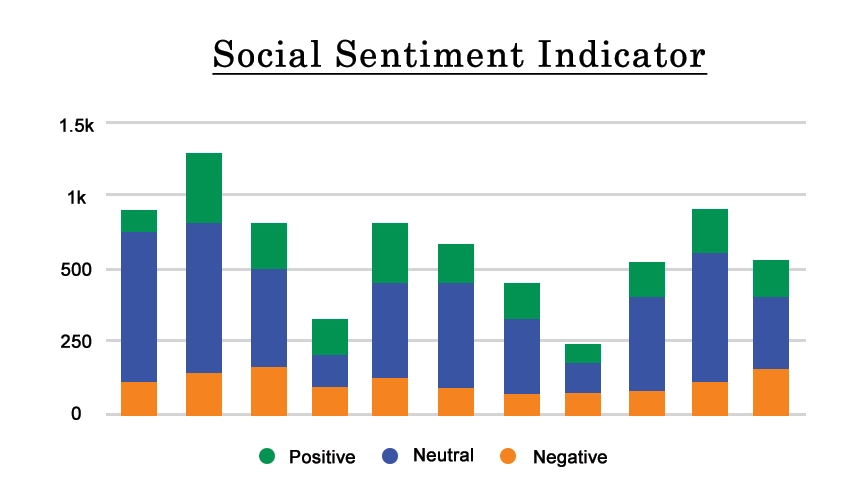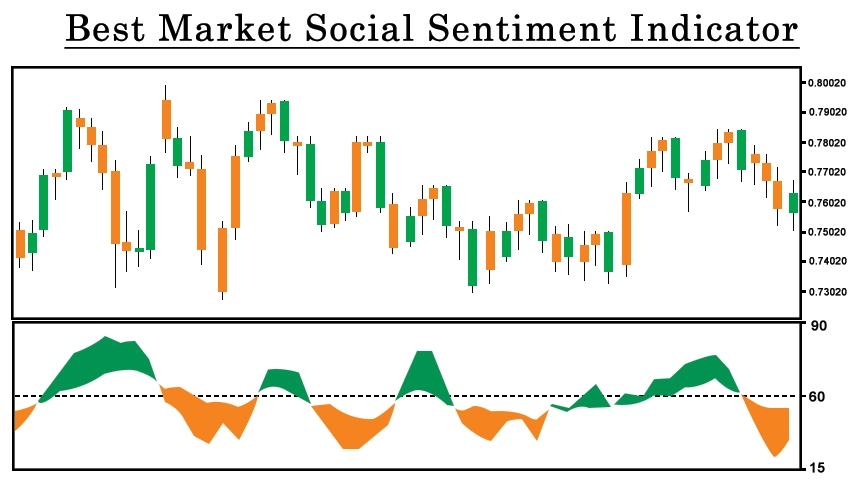Social Sentiment Indicator: Works, Advantages, and Example
What Is a Social Sentiment Indicator?
A social sentiment indicator primarily focuses on analyzing social media data to assess how a company or brand is perceived by consumers. By monitoring the sentiment expressed in social media conversations, businesses can gain insights into customer satisfaction, identify areas for improvement, and measure the effectiveness of their marketing strategies.
Social sentiment indicators allow companies to track public opinion, understand customer preferences, and address any negative sentiments or issues that may arise. These indicators can help businesses identify trends, sentiment shifts, and emerging issues in real time, enabling them to make timely decisions and take appropriate actions.

Social Sentiment Indicators are often used in various fields, including marketing, finance, and public opinion research. By monitoring social sentiment, companies can assess the perception of their brand or product among customers and make informed decisions about marketing strategies or product improvements. In finance, sentiment indicators can help investors gauge market sentiment indicators India and make predictions about market movements. Additionally, governments and organizations may use sentiment indicators to monitor public opinion on specific issues or policies.
There are different approaches to measuring social sentiment score, ranging from manual analysis of social media sentiment analysis example content to sophisticated algorithms that employ natural language processing and machine learning techniques. These methods typically involve analyzing text data, such as tweets, posts, comments, or reviews, and assigning sentiment scores based on the language used, sentiment-laden words, or sentiment analysis models.
How a Social Sentiment Indicator Works
A social sentiment indicator works by analyzing and interpreting data from social media platforms and other online sources to determine the prevailing sentiment or mood within a particular group or population. The indicator uses various techniques, such as natural language processing and machine learning algorithms, to analyze the content, context, and language used in social media posts, comments, reviews, and other user-generated content.
The process typically involves several steps. First, the indicator collects and aggregates data from social media platforms or other relevant sources, focusing on specific keywords, hashtags, or topics of interest. Next, it cleans and preprocesses the data by removing noise, irrelevant content, or duplicate entries.
Once the data is prepared, the sentiment analysis algorithm is applied. The algorithm classifies each piece of content as positive, negative, or neutral based on the sentiment expressed. It considers factors such as the choice of words, phrases, emotions, and sentiment-laden expressions within the text.
The sentiment analysis algorithm may utilize pre-trained models or custom-built models trained on large datasets to accurately classify sentiment. These models often incorporate techniques such as word embeddings, sentiment lexicons, or deep learning architectures to enhance the accuracy of sentiment classification.
After sentiment classification, the social sentiment indicator stocks calculate the overall sentiment by aggregating the sentiment scores from all the analyzed content. This can be done by calculating the proportion or percentage of positive, negative, and neutral sentiments. Some indicators also take into account the intensity or strength of the sentiment expressed to provide a more nuanced understanding of the sentiment.
The final output of a social sentiment indicator can be represented as a sentiment score, sentiment index, sentiment trend, or visual representations such as charts or graphs. This information helps businesses, organizations, or investors understand the prevailing sentiment, identify patterns or trends, and make data-driven decisions based on public sentiment.
Advantages of Social Sentiment Indicators
Social sentiment indicators offer several advantages for businesses and other stakeholders. Here are some key advantages:
1. Real-time insights: Social sentiment indicators provide real-time information about public sentiment. By analyzing social media data in near real-time, businesses can quickly identify emerging trends, customer opinions, and potential issues. This enables them to respond promptly and make timely adjustments to their strategies, products, or services.
2. Customer feedback: Social sentiment indicators allow businesses to gather customer feedback on a large scale. By monitoring social media conversations, companies can gain valuable insights into customer preferences, satisfaction levels, and pain points. This feedback can inform product development, marketing campaigns, and customer service improvements.
3. Competitive analysis: Social sentiment indicators help companies assess their performance relative to competitors. By analyzing sentiment trends across different brands or products, businesses can understand how they compare in terms of customer sentiment. This information can be used to identify competitive advantages, benchmark against industry leaders, and uncover areas for differentiation.
4. Reputation management: Social sentiment analysis benefits indicators play a crucial role in reputation management. They help businesses monitor their online reputation and identify any negative sentiment or potential PR crises. By proactively addressing customer concerns or negative sentiment, companies can protect their brand reputation and maintain a positive image.
5. Influencer identification: Social sentiment indicators can help identify influential individuals or communities within social media networks. By analyzing sentiment and engagement levels, businesses can identify key influencers who can positively impact their brand perception and reach a larger audience. Collaborating with influencers can lead to increased brand visibility, credibility, and customer engagement.
6. Market insights: Social sentiment indicators can provide valuable market insights. By analyzing sentiment data across a broader population, businesses can gain a deeper understanding of consumer preferences, needs, and emerging market trends. This information can inform market social indicator research, social indicators in India product positioning, and strategic decision-making.
7. Investor sentiment: In addition to its benefits for businesses, social sentiment indicators can also provide insights for investors. By monitoring social sentiment related to specific publicly-listed stocks or sectors, investors can gauge market sentiment, anticipate market movements, and make more informed investment decisions.
Examples of Social Sentiment Indicators
Sports and Entertainment
Sports and entertainment companies often use social sentiment indicators to enhance the viewing experience for customers. In line with this, IBM, a technology giant, created its own social sentiment indicator to capitalize on the interest in online commentary. This tool allows sports fans to access information about the number of tweets and the positive or negative trend associated with each player, providing viewers with a real-time understanding of how other spectators are perceiving a match.
Economy
There are specific measures used to assess how the public perceives the economy. One example is the Daily News Sentiment Index, which evaluates economic sentiment by analyzing relevant news articles. This index considers economic news from various sources, including well-known media outlets like The New York Times and The Washington Post. The information is compiled by Factiva, a business and information tool.

0 comments